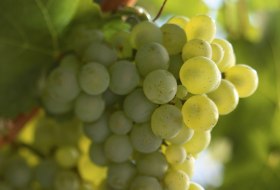The origin is complicated and is partly in the dark. There is a parent-offspring relationship with the Traminer variety. The second parent is unknown.
The origin of the variety is on the Loire, where it is first mentioned in a document in the 16th century, but Sauvignon Blanc came to Germany much later. It was cultivated as a nutmeg Sylvaner until the mid-1930s. Under the Nazis, the cultivation was banned - with the indication that it was an "enemy wine". Sauvignon Blanc remained under the radar for a long time in Germany even after the Second World War.
Today Sauvignon Blanc can no longer be overlooked on the Rheinhessen white wine stage. With 540 hectares of vineyards (2% of the Rheinhessen vineyards) and double-digit growth rates, Sauvignon Blanc is currently the shooting star in the region's vineyards.
Linguists derive the name Sauvignon from the French "sauvage", in German "wild". This gives a first indication of the wine characteristics. Sauvignon Blanc has an unmistakable identity of freshness and distinctive acidity.
The aromatic cocktail of grass, herbs, gooseberries, elderberries and green fruits is very special and therefore easily recognizable. The oenologists attribute this to the pyrazine content. These are very potent flavorings with an extremely low odor threshold. It is in the range of a few billionths of a gram per liter - but this touch of nothing puts a distinctive stamp on the Sauvignon Blanc and is gaining more and more enthusiastic fans.
The Sauvignon Blanc with its freshness kick goes well with fish dishes and seafood - from fried prawns to mussels and scampi. Sauvignon blanc is also a good choice with veal and poultry dishes. Sauvignon Blanc wines also go wonderfully with vegetables and pasta with cream sauce.


